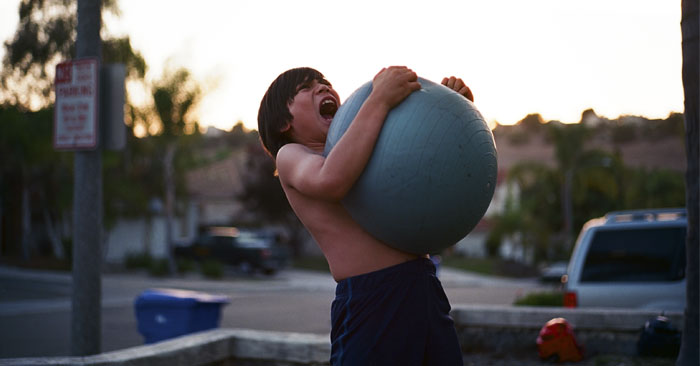 Dr. Laura Markham
Dr. Laura Markham
Founder of AhaParenting.com | Author
Let’s say we see behavior — bouncing a soccer ball in the house — that’s against our family rules. We set a limit, in this case by giving our child a choice of two alternate, acceptable, options. He ignores us. We repeat. He ignores us.
 Naturally, we’re frustrated. We feel an intense need to teach our child a lesson. Shouldn’t there be a “consequence”?
Naturally, we’re frustrated. We feel an intense need to teach our child a lesson. Shouldn’t there be a “consequence”?
Yes. Clearly, we need to take the ball away, to uphold our family rule about where balls can be used. But that isn’t a “consequence” (as parents usually use the term) unless we also punish him for not obeying.
Your child still learns a lesson. In fact, if you can resist your urge for punishment, he’ll WANT to make amends. Really.
Let’s take this one step at a time.
1. Your son is bouncing the ball in the house…
…which he knows is against the family rules. You’re worried about the walls getting scuffed. You need to set a limit.
If you’re doing daily preventive maintenance — connecting with warmth and empathy, spending one on one time — your child will always be more cooperative. So you can usually just set a clear, kind limit:
and hold open the door, and he’ll comply.
What do I mean by connecting with warmth and empathy? Your basic 24/7 response to him is seeing things from his perspective, with compassion. In other words, what comes out of your mouth is mostly warm and “connecting,” even when you’re “correcting.”
2. Do you need to give him a choice?
Some younger kids feel overwhelmed by choices. But strong-willed kids, even more than the rest of us, react badly when they feel backed into a corner. So this skillful mom is giving her child a choice of where to bounce the ball. She could also offer the choice of finding a different activity.
3. He ignores you.
Infuriating, right? But maybe he’s not being defiant; he’s just really focused on his ball skills and doesn’t even hear you. Or maybe you haven’t been connecting with him much lately, and this is your red flag that you need to spend some dedicated special time with him daily, starting tonight. Or maybe he knows from past experience that there’s a good chance you’ll give up and leave him alone. Or maybe he’s just a strong-willed kid, who needs to push on a limit 100 times to see if it holds firm (otherwise known as an “experiential learner.”)
So he ignores you.
Do you repeat yourself? No!
If you’ve asked once and not gotten a response, don’t just repeat yourself. You don’t have your child’s attention yet. Instead, you get in his face in a friendly way, so he gets that you mean it.
So in this case, you walk over to your son and — hopefully with a smile on your face, but at least with a neutral expression — you intercept the soccer ball. You hold the ball in one arm, putting the other arm around his shoulder. He looks up at you, aggravated.
4. You connect before you correct.
How do you feel when someone implies that you’re wrong? A little bristly? An urgent need to prove you’re right, or to fight back? That’s how your child feels, too. And it’s not exactly a recipe for cooperation.
You can avoid that resistance by reconnecting before you “correct.” He’s much more likely to really hear you, and to care what you want, which means he’s more likely to cooperate.
Connect by seeing his perspective, even as you set your limit.
As you speak, you are walking him towards the door. You open it, and as he goes out, you give him the ball, and a smile.
5. Find a win/win solution.
Usually, that’s the end of the incident. You’ve enforced your limit. If you do this regularly, your son will skip the inside bouncing and head straight outdoors, because who wants parents interrupting when they’re practicing ball skills?
But maybe you only have a lawn outside and the ball doesn’t bounce there. In that case, he will almost certainly keep using your hallway. Time to problem-solve with a win/win solution.
Notice your child has to delay gratification. That’s not easy. But if you’re maintaining a positive connection, he’ll be a lot more motivated.
6. Should you take the ball away?
If your child is using a toy in an unsafe way, and does not respond to your redirection, then of course you take the toy away.
Notice this is not a punishment. You are simply redirecting your child’s energy.
7. Teach Your Child to Repair.
Let’s say you come upon your son bouncing his ball in the hall, and you notice scuff marks on the wall. You say:
Now, if you do this in a blaming way, he’ll naturally go on the defensive and resist. That’s when kids say things like “You do it!” But if you can do this cheerfully, without blame, from the time your child is little, he’ll comply. And he’ll also start taking the ball outside without your intervention, because who wants to clean the walls when they could be outside doing soccer drills?
8. Shouldn’t there be a “consequence”?
Of course! Look at all the consequences of what happened here! Your son has learned:
- When mom tells me to do something, she means it. There’s no point in trying to ignore her.
- Bouncing the ball in the house scuffs the wall and I’m responsible to help clean up the scuff marks…I’d rather just go outside with the ball.
- I make mistakes, but Mom always understands.
- I repair my mistakes and clean up my own messes.
- My mom really cares about what I want. So I care about what she wants.
- If I don’t like what Mom tells me to do, she listens and tries to find a good solution for both of us.
- I’m good at finding solutions.
- If I use a toy unsafely, I have to find another activity.
- I don’t always get what I want, but I get something better — a parent who understands.
- Everyone in our family takes our family rules seriously. The most important one is treating each other with respect and kindness.
By contrast, if you had punished him — which is what parents usually mean by “consequences” — what would he have learned?
- She’s always yelling and punishing me. Why should I do what she wants?
- When I bounce the ball in the house, she takes it away and punishes me. But not until she’s yelling. So I don’t have to listen until she yells and takes the ball away. I know just how far to push it before I get a consequence.
- She took my ball. I’m going to annoy my sister. In fact, I’m going to make this afternoon miserable for everyone.
- When she’s not here, I’ll bounce the ball in the house as much as I want.
- No, I don’t know who made those scuff marks. (I’m getting good at lying.)
- She can’t make me.
The truth is, we can’t make another human being do what we want. We can only help them WANT to. Loving guidance and empathic limits help your child WANT to follow your guidance, so those good habits become part of who he is, whether you’re there or not. “Consequences” that are designed to punish? Just the opposite.
The difference between loving limits and consequences? There’s no room for punishment in loving limits.
This post was originally posted at AhaParenting.com on 11/17/16
About Dr. Laura Markham
 Dr. Laura Markham is the founder of AhaParenting.com and author of Peaceful Parent, Happy Kids: How To Stop Yelling and Start Connecting and Peaceful Parent, Happy Siblings: How to Stop the Fighting and Raise Friends for Life. Dr. Laura says that earning her PhD in clinical psychology at Columbia University was just the beginning of her education as a psychologist. Becoming a mother convinced her that parents are doing the hardest job in the world, and need more support. She says her aspiration is to change the world, one child at a time — by supporting parents.
Dr. Laura Markham is the founder of AhaParenting.com and author of Peaceful Parent, Happy Kids: How To Stop Yelling and Start Connecting and Peaceful Parent, Happy Siblings: How to Stop the Fighting and Raise Friends for Life. Dr. Laura says that earning her PhD in clinical psychology at Columbia University was just the beginning of her education as a psychologist. Becoming a mother convinced her that parents are doing the hardest job in the world, and need more support. She says her aspiration is to change the world, one child at a time — by supporting parents.
View all posts by Dr. Laura Markham here.
Save






One Comment on “What’s the Difference Between Limits and Consequences?”
After raising 2 children i knew a thing or two by the time grandkids came along we always discuss consequences even sometimes making a game of it. At 10/11 they know that every word or action comes a consequence and that’s a good thing to know.